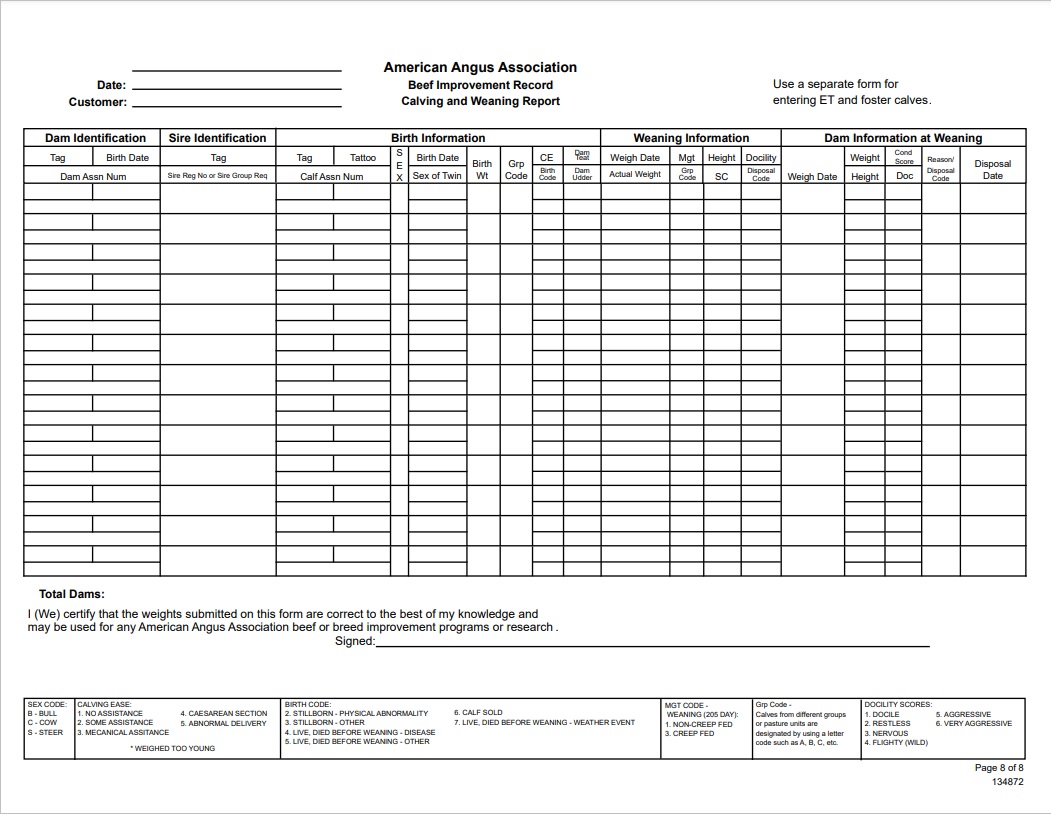
The Calving and Weaning Report is utilized by many breeders as their first introduction
to Angus Herd Improvement Records (AHIR). The report is a listing of all registered
and commercial females in your herd that are 12 months old or older at time of printing.
If you have data to report for commercial dams that are not listed on the report,
a herd ID and birthdate is required.
To complete the calving information, you will fill in the sire's registration number
(breeders can also enter a sire's tag number or within-herd I.D. number), calf tag
number and tattoo, sex, actual birthdate (mm/dd/yy), birth weight and calving ease
score. Birth weights must be measured by a scale and reported in pounds. Estimated
birth weights from other methods are not accepted (e.g., hoof circumference or heart
girth body weight tapes). As your calves are born, it is important to consistently
weigh within 24 hours. The birth code column is for reporting any irregular calving
situation, including death loss or the sale of calves pre-weaning.
Weigh Calves Between 120-280 Days
The date calves are weighed at weaning and the actual weight is placed in the first
column under calf weight data. The acceptable range for weaning weights is between
120 and 280 days of age.
Enter Management Codes
The column for management code designates whether or not the calves were creep-fed
or supplied supplemental feeding.
Non-creep fed calves are reported as code 1 and
creep-fed calves are reported as code 3.
The management code must be completed
before weights will be processed.
Enter Group Code
Knowledge of calves that are "contemporaries" is critical for accurate data evaluation.
A group code is used to designate a set of calves managed differently from another
set of calves.
Calves from different groups or pasture units are designated by using
a letter code such as A, B, C, etc.
For example, calves from two-year old
dams in one pasture may be reported as Group A and calves from mature cows in another
pasture as Group B.
Breeders submitting weaning weights will automatically have their heifers and bulls
(or steers) treated as separate sex groups and ratioed as separate sex groups. Use
the group code to separate the sex groups of calves, if desired. If not instructed
differently, each weaning group is treated as one unit for calculating ratios. A
contemporary code is required when submitting calving and weaning weights.
Enter Optional Data
An optional column is included for a weaning hip height and scrotal circumference.
When reporting heights, submit actual hip height. Also, location may be specified.
User-defined codes may be placed in the custom field.
When to Send in Weights
As soon as a group of calves have been weighed, you should mail the
Calving and Weaning
Report
in the envelope provided. A new Calving and Weaning Report
will then be sent to you with the Weaning Summary.
When to Collect Cow Data
Cows should be measured for weight, hip height, and condition score within +/- 45
days of the calf's weaning measure date. It is important to collect this information
after the cow has weaned her first calf, and subsequent years.
A body condition
score must be included with the cow weight in order for data to be utilized
in the National Cattle Evaluation.
Cow Body Condition Scores
-
Severely emaciated. All ribs and bone structure easily visible. Very little visible
muscle tissue, physically weak.
- Emaciated. Similar to score one, but not weakened. Little visible muscle tissue.
-
Very thin. No fat on ribs or brisket. More apparent muscling than on condition score
two. Backbone easily visible.
-
Thin or with ribs easily visible, but shoulders and hindquarters show fair muscling.
Backbone visible.
-
Moderate to thin. Last two or three ribs can be seen. Little evidence of fat on
brisket, over ribs, or around tail head.
-
Good condition. Smooth appearance throughout. Slight fat deposition on brisket and
over tail head. Ribs covered, and backs appear slightly rounded.
-
Very good condition. Brisket full. Tail head shows pockets of fat. Back appears
well rounded due to fat. Ribs very smooth.
-
Obese. Back square due to fat. Brisket distended. Heavy fat pockets around tail
head. Neck thick.
-
Rarely seen. Very obese. Similar to condition score eight, except more extreme.
Heavy deposition of udder fat.
Cow Disposal and Reason Codes
For complete herd inventory analysis, each cow listed on the Calving and Weaning
Report must have birth or weaning data, a Disposal Code or a Reason Code listed.
Disposal Codes Any cow leaving the herd throughout the production cycle must
be given a disposal date (mm/dd/yy) and a disposal code. To see
a full list of disposal codes, click here.
60
Culled - Calving Problem
38
Culled - Fell out of calving season
33
Culled - Fertility or Open
41
Culled - Condition Status
61
Culled - Genetic Predictions(EPDs)
40
Culled - Illness or Disease
63
Culled - Pelvic Measurement or RTS
64
Culled - Progeny Performance
31
Culled - Teat and Udder
42
Culled - Weather Event
29
Culled - Miscellaneous
65
Died - Illness or Disease
Reason Codes If a cow remains in your herd, but does not have a calving or weaning record for the current year, please complete the reason code for her to remain as an active dam in your herd.
50
Open, cow missed calving opportunity
52
Cow moved to next calving season
53
ET program/recipient cow
55
Multi-owned, No possession

